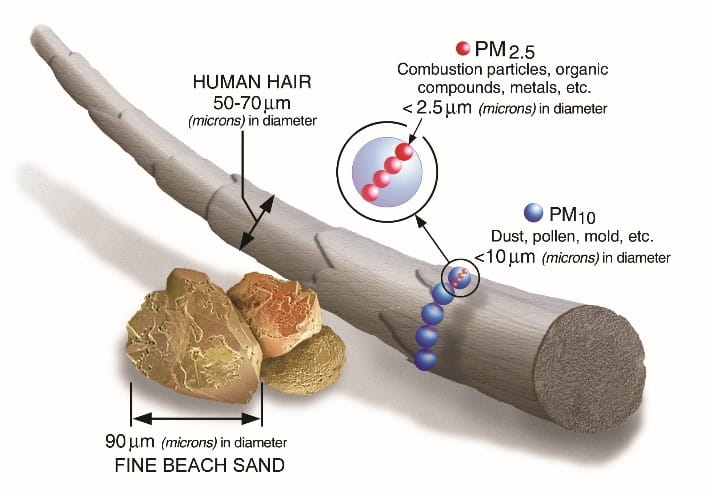The web Browser you are currently using is unsupported, and some features of this site may not work as intended. Please update to a modern browser such as Chrome, Firefox or Edge to experience all features Michigan.gov has to offer.
Michigan prepares to meet new, more stringent federal standards on fine particulate pollution
February 29, 2024
New, more protective standards for fine particulate matter were announced recently by the United States Environmental Protection Agency (EPA). This is a positive step that will allow Michigan to build on the progress we have made in reducing pollution and protect more of our residents from airborne hazards.

Particulate matter -- EPA's particulate matter basics
We are committed to meeting the new, more stringent, standard as EPA starts the multi-year implementation process. EPA’s announcement starts a schedule requiring us to analyze data, make recommendations for area designations, and develop and implement plans to reach attainment statewide. EPA will consider our analyses and recommendations when they decide the designations for different areas of the state. There are likely to be areas already meeting the standard and areas where action will be needed to further improve particulate pollution.
To help understand how this standard may impact the state and what the time frame looks like, we’ve asked for answers to key questions from our EGLE Air Quality Division experts.
What is fine particulate matter?
Fine particulate matter is also called PM2.5. It refers to small particles that are less than 2.5 microns in diameter.
Why are we concerned about PM2.5?
A growing body of science links particle pollution to a range of serious and sometimes deadly illnesses. Many studies show that these microscopic fine particles can penetrate deep into the lungs where they stick. Long- and short-term exposure can lead to asthma attacks, missed days of school or work, heart attacks, expensive emergency room visits and premature death.
What is the new EPA standard for fine particulate matter?
The new standard reduces the threshold for PM2.5 from a level of 12 micrograms per cubic meter (µg/m3) to 9 µg/m3.
Does the new EPA standard mean the air is unhealthy?
No. Michigan’s air has significantly improved over the last several decades as PM 2.5 and other pollutants have been reduced due to more protective pollution standards, cleaner energy sources and technological advances. This progress has resulted in safer air for all Michiganders. Although these downward trends are positive, EPA continues to look at the standard and all available health-based science to ensure health risks are minimized. In the most recent round of analysis, EPA found that risks may be present at lower pollution levels than previously believed. These new standards will drive even further pollution reductions that will make our air quality safer for all Michiganders.
How has PM2.5 pollution been trending in Michigan?
The last several decades have shown decreases in fine particulate pollution across the state. This is a result of more protective standards, technological advances, and the Energy Sector’s transition away from coal-fired power plants.

Data from some of the state's PM2.5 air monitors over time.
Will the new standard put parts of Michigan out of attainment?
EGLE expects EPA to make the final designations for the new PM2.5 standard based on air monitoring data from 2022-2024 (and possibly 2023-2025). As such, there’s additional data collection and substantial data analysis to be completed before final designations are made. It is likely that areas in and around Detroit will be designated as being in ‘nonattainment’ with the standard. Other areas of the state may also be designated in ‘nonattainment’, but it’s too early to say with certainty.
Will new rules and strategies be required to meet the new standard?
Yes, a revision to the State Implementation Plan (SIP) will be developed and submitted to EPA. The SIP revision will include emission reductions measures required by the federal Clean Air Act, including new rules to reduce emissions that contribute to PM2.5 pollution. The state’s transition to cleaner energy sources, electrification of vehicles and more efficient pollution controls on industrial sources should help drive down fine particulate matter going forward. While additional analysis is needed, these measures collectively may be enough for the state to meet the new standard by 2032.
What about the Canadian wildfire pollution that was so prevalent last year?
That is certainly a wildcard that may affect Michigan pollution levels. Wildfires are not reasonably controllable by regulatory agencies and as such, their impacts on monitoring data can be excluded for regulatory determinations. We are evaluating the monitoring and weather data against federal Exceptional Events guidance given to us by EPA. Later this year, after completing this rigorous evaluation for the various areas of the state, EGLE will determine whether to seek concurrence from EPA on any Exceptional Events Demonstrations.
We look forward to working closely with EPA, state, local and tribal partners as we move toward attaining the revised federal standard. We will be sharing our progress and our state’s designations as they become available.